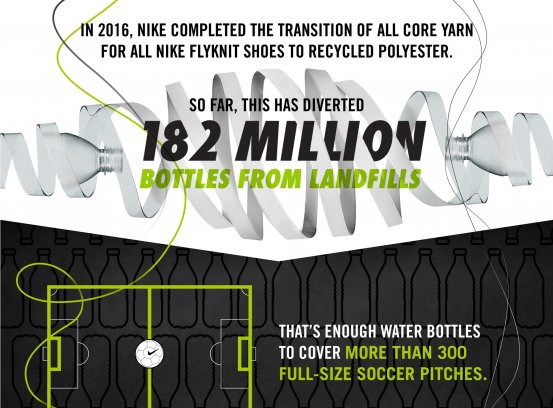
Nike accuses Puma of copying FlyKnit
So far, this has diverted 182 million plastic bottles from ending up in landfills, the company reports.

4th March 2016
Knitting Industry
|
Portland, OR
Four years since introducing the first shoe model made with the seamless knitting technology, sportswear and sports shoe giant Nike has completed the transition of all core yarn for all Nike Flyknit shoes to recycled polyester.
So far, according to the company, this has diverted 182 million plastic bottles from ending up in landfills. “That’s enough water bottles to cover more than 300 full-size soccer pitches,” the company reports.
Nike Flyknit represents a quantum leap for flat knitting technology. Its introduction heralded a new era for integrally knitted non-apparel products, which can be manufactured on a large scale to meet global demand.
According to the manufacturer, Flyknit also breaks the mould of sustainable performance, by shaving ounces off each shoe upper, as well as saving millions of pounds of waste from ever reaching landfills.
Flyknit production process is said to reduce waste by about 60% on average compared to cut & sew footwear, according to the company. Since 2012, Flyknit has reduced nearly 3.5 million pounds of waste.
In 2012, Nike embarked on a four-year mission of micro-engineering static properties into pliable materials. It required teams of programmers, engineers and designers to create the proprietary technology needed to create the knitted upper.
The next steps were to map out where the specific yarn and knitted structures were needed. Applying 40 years of knowledge from working with runners, Nike says it refined the precise placement of support, flexibility and breathability - all in one layer.
"The result is precision engineering in its purest form, performance on display. Every element has a purpose: resulting in one of the lightest, best fitting running shoes NIKE has ever made," Nike explained.
Following more than ten years of research activities, the first model, Flyknit Racer, was unveiled publicly in February 2012, featuring a lightweight, formfitting upper. The model was followed by HTM Trainer+ with enhanced fit and more focus put on aesthetics.
In January 2013, HTM Flyknit Chukka was presented for improved breathable comfort and support. Later that year, the company produces six more designs across three different categories and expands into football and other sports applications.
By the autumn 2015, Nike developed 28 models across six categories for running, training, sportswear, football, basketball and US football. The company reached 500 global Flyknit-related patents for technology and design.
Download the full infographic capturing four years of Flyknit

Business intelligence for the fibre, textiles and apparel industries: technologies, innovations, markets, investments, trade policy, sourcing, strategy...
Find out more